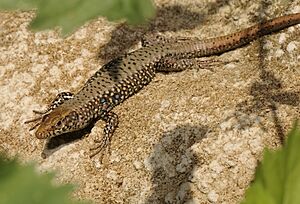Greek rock lizard facts for kids
Quick facts for kids Greek rock lizard |
|
|---|---|
 |
|
| Conservation status | |
| Scientific classification | |
| Genus: |
Hellenolacerta
|
| Species: |
graeca
|
| Synonyms | |
|
Lacerta graeca |
|
The Greek rock lizard (Hellenolacerta graeca) is a type of lizard that belongs to the Lacertidae family. This lizard is found only in Greece. It lives in places like temperate forests, shrubby areas, rocky spots, and pastureland. Sadly, its home is shrinking, which puts it at risk. The International Union for Conservation of Nature says it is "near threatened".
Contents
What it Looks Like
The Greek rock lizard is a medium-sized lizard. Its body, from its nose to where its tail starts, is about 8 cm (3 in) long. Its tail is at least twice as long as its body!
This lizard has a somewhat flat body. Its legs are long and thin. Usually, it's a shiny grayish-brown color. Sometimes, it might look more yellowish-brown or even have a slight reddish tint.
Male lizards often have dark, uneven spots on their backs. Their sides are dark with many small, light-colored spots. Female lizards have smaller heads. They have fewer dark spots on their backs. The light spots on their sides are also less clear.
Sometimes, you might see one or two blue spots above their shoulders. In males, these blue spots can go a little way down their sides. The lizard's belly is yellow or orange. It usually has tiny dark marks, especially on its throat.
Where it Lives
The Greek rock lizard lives only in southern Greece. You can find it in the Peloponnese region. It lives at different heights, from about 300 metres (980 ft) to 700 metres (2,300 ft) above sea level. Some have been found as high as 1,600 metres (5,200 ft).
These lizards usually live near streams and pools. They like light woodlands and the edges of fields next to forests. You can also find them in shady, rocky areas or places with loose rocks. They prefer rocky homes that are also a bit damp.
How it Behaves and Reproduces
The Greek rock lizard is very quick and good at climbing. It climbs on rocks, walls, low fences, and tree trunks. However, it tries to avoid staying in direct sunlight for too long. Even though it's mostly a climber, it sometimes looks for food on the ground.
Female Greek rock lizards lay one group of eggs at a time. They can lay up to six eggs. They hide their eggs in a crack or a secret spot. The eggs take about six weeks to hatch.
Its Future and Conservation Status
The Greek rock lizard faces some big dangers. Fires are a major threat to its home. Also, people sometimes plant Eucalyptus trees where the lizard's natural plants used to grow. This takes away their habitat.
Even though you can find many of these lizards in some places, their total living area is quite small. It's only about 20,000 square kilometres (7,700 sq mi). As good places for them to live shrink, their numbers are going down.
Because of these threats, the International Union for Conservation of Nature has listed the Greek rock lizard as "near threatened". This means it's close to becoming a "vulnerable" species, which would be a bigger worry for its survival.


